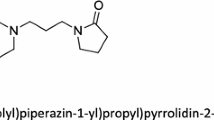Abstract
The study showed that chronic stimulation of peripheral μ- and δ-opiate receptors by a course of intravenous D-Ala2–Leu5-Arg6-enkephalin (dalargin) causes an antianginal effect in patients with ischemic heart disease (IHD) and increases tolerance to exercise in patients with atherosclerosis of coronary and peripheral arteries. Prolonged activation of peripheral μ- and δ-receptors causes a venodilator effect and decreases the tone of peripheral arteries in patients with IHD and atherosclerosis of lower extremities. After a course of dalargin, the chronotropic response to exercise strengthens in patients with IHD and the hypertensive response to threshold exercise weakens in patients with atherosclerosis of lower extremities.
Similar content being viewed by others
REFERENCES
Hughes, J., Smith, T.W., Kosterlitz, H.W., et al., Identification of Two Related Pentapeptides from the Brain with Potent Opiate Agonist Activity, Nature, 1975, vol. 258, p. 577.
Pasternak, G.W., Simantov, R., and Snyder, S.H., Characterization of an Endogenous Morphine-like Factor (Enkephalin) in Mammalian Brain, Mol. Pharmacol., 1976, vol. 12, p. 504.
Bradbury, A.F., Smyth, D.G., Snerr, C.R., et al., C-Fragment of Lipoprotein Has a High Affinity for Brain Opiate Receptors, Nature, 1976, vol. 260, p. 793.
Cox, B.M., Goldstein, A., and Li, C.H., Opioid Activity of a Peptide, Beta-Endorphin (61-91), Derived from Beta-Lipotropin, Proc. Natl. Acad. Sci. USA, 1976, vol. 73, p. 1821.
Li, C.H. and Chung, D., Isolation and Structure of an Untriakontapeptide with Opiate Activity from Camel Pituitary Glands, Proc. Natl. Acad. Sci. USA, 1976, vol. 73, p. 1145.
Goldstein, A., Fischli, W., Lowney, L.I., et al., Porcine Pituitary Dynorphin: Complete Amino Acid Sequence of the Biologically Active Heptadecapeptide, Proc. Natl. Acad. Sci. USA, 1981, vol. 78, p. 7219.
Zadina, J.E., Hackler, L., Ge, L.-J., and Kastin, A.J., A Potent and Selective Endogenous Agonist for the μ-Opiate Receptor, Nature, 1997, vol. 386, p. 499.
Dhawan, B.N., Cesselin, F., Raghubir, R., et al., International Union of Pharmacology. XII. Classification of Opioid Receptors, Pharmacol. Rev., 1996, vol. 48, no. 4, p. 567.
Sander, G.E., Lowe, R.F., Given, M.B., and Giles, T.D., Interactions between Circulating Peptides and the Central Nervous System in Hemodynamic Regulation, Am. J. Cardiol. 1989, vol. 64, p. 44C.
Willette, R. and Sapru, H., Pulmonary Opiate Receptor Activation Evokes a Cardiorespiratory Reflex, Eur. J. Pharmacol., 1982, vol. 78, p. 61.
Giles, T.D., Sander, G.E., Rice, J.C., and Quiroz, A.C., Systemic Methionine-Enkephalin Evokes Cardiostimulatory Responses in the Human, Peptides, 1987, vol. 8, p. 609.
Korobov, N.V., Dalargine, an Opioid-like Peptide with Peripheral Effect, Farmakol. Toksikol., 1988, no. 4, p. 35.
Lishmanov, Yu.B. and Maslov, L.N., Opioidnye neiropeptidy, stress i adaptatsionnaya zashchita serdtsa (Opioid Neuropeptides, Stress, and Adaptive Protection of the Heart), Tomsk: Tomsk. Gos. Univ., 1994.
Pokrovskii, A.V., Klinicheskaya angiologiya (Clinical Angiology), Moscow: Meditsina, 1979.
Bruse, R.A., Exercise Testing of Patients with Coronary Heart Disease, Ann. Clin. Res., 1971, vol. 3, no. 4, p. 323.
Gorbachev, V.V., Ischemic Heart Disease, in Prakticheskaya kardiologiya (Practical Cardiology), Gorbachev, V.V., Ed., Minsk: Vysheishaya Shkola, 1997, vol. 1, p. 127.
Gasilin, V.V. and Sidorenko, B.A., Stenokardiya (Angina Pectoris), Moscow: Meditsina, 1987.
Pushkar', Yu.T., Bol'shov, V.M., and Elizarova, N.A., Determination of Cardiac Release by Tetrapolar Chest Rheography and Its Metrological Capacities, Kardiologiya, 1977, no. 7, p. 85.
Pushkar', Yu.T., Tsvetkova, A.A., and Kheimets, G.I., Automated Determination of Minute Volume by Rheography, Byull. VKNTs AMN SSSR, 1980, no. 1, p. 45.
Mukharlamov, N.M., Sazonova, L.N., and Pushkar', Yu.T., Study of Peripheral Circulation by Automated Occlusive Plethysmography, Ter. Arkhiv, 1981, no. 12, p. 3.
Polonskii, V.M., Yarygin, K.N., and Krivosheev, I.G., Application Site (Central vs. Peripheral) of Antiulcerous Effect of Dalargin, a Synthetic Analog of Endogenous Opioids, in Experimental Model of Cystaminic Duodenal Ulcers in Rats, Byull. Eksp. Biol. Med., 1987, no. 4, p. 433.
Gerts, A. and Millan, M., Participation of Opioids and Opiate Receptors in Antinoniciception at Various Levels of the Nervous System, Farmakol. Toksikol., 1989, vol. 52, no. 3, p. 5.
Champion, H.C. and Kadowitz, P.J., D-[Ala2]endomorphin 2 and endomorphin 2 Have Nitric Oxide-dependent Vasodilator Activity in Rats, Am. J. Physiol., 1998, vol. 274, p. H1690.
Metelitsa, V.I., Spravochnik po klinicheskoi farmakologii serdechno-sosudistykh lekarstvennykh sredstv (Directory in Clinical Pharmacology of Cardiovascular Medicines), Moscow: Medpraktika, 1996.
Lishmanov, Yu.B., Maslov, L.N., Tam, S.V., and Bogomaz, S.A., Opioid System and Resistance of the Heart to Injuries in Patients with Ischemia-Reperfusion, Ross. Fiziol. Zh., 2000, vol. 86, no. 2, p. 164.
Schultz, J.E.J., Hsu, A.K., Nagase, H., and Gross, G.J., TAN-67, a δ1-Opioid Receptor Agonist, Reduces Infarct Size via Activation of Gi/o Proteins and KATP Channels, Am. J. Physiol., 1998, vol. 274, p. H909.
Samarenko, M.B. and Karpov, Yu.A., First Experience of the Clinical Application of Dalargin, a Domestic Synthetic Peptide, in Patients with Ischemic Heart Disease, Byull. VKNTs AMN SSSR, 1983, no. 2, p. 96.
Kalenikova, E.I., Dmitrieva, O.F., Korobov, N.V., et al., Pharmacokinetics of Dalargin, Vopr. Med. Khim., 1988, no. 1, p. 75.
Zaitsev, S.V., Vinogradova, V.A., Sergeeva, M.G., et al., Radioimmune and Radioreceptor Study of Pharmacokinetics of Dalargin, an Analog of Enkephalins, Byull. Eksper. Biol. Med., 1986, no. 6, p. 702.
Goldstein, A., Nestor, J.J., Naidu, A., and Newman, S.R., “DAKLI”: a Multipurpose Ligand with High Affinity and Selectivity for dynorphin (Кopioid) Binding Sites, Proc. Natl. Acad. Sci. USA, 1988, vol. 85, p. 7375.
Author information
Authors and Affiliations
Rights and permissions
About this article
Cite this article
Maslov, L.N., Fedorova, N.A., Dudko, V.A. et al. Influence of Dalargin, a Peripheral Opiate Receptor Agonist, on Exercise Tolerance in Patients with Coronary and Peripheral Artery Atherosclerosis. Human Physiology 28, 581–586 (2002). https://doi.org/10.1023/A:1020282919749
Issue Date:
DOI: https://doi.org/10.1023/A:1020282919749




